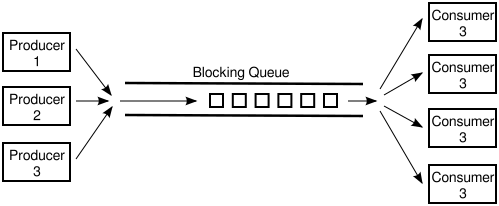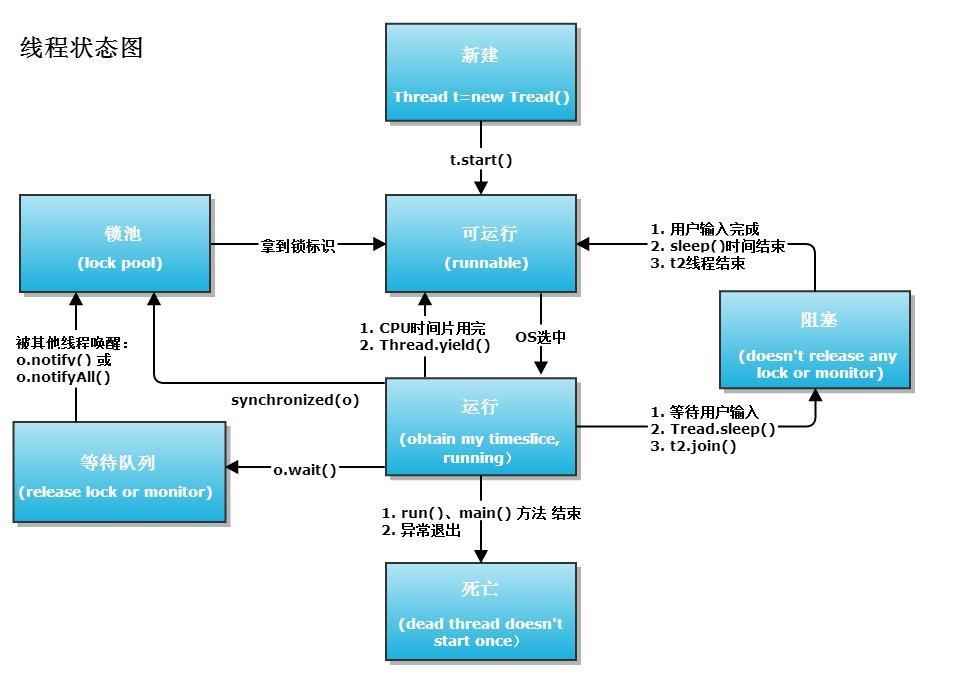生产者消费者问题是线程模型中的经典问题:生产者和消费者在同一时间段内共用同一存储空间,生产者向空间里生产数据,而消费者取走数据。
阻塞队列就相当于一个缓冲区,平衡了生产者和消费者的处理能力。这个阻塞队列就是用来给生产者和消费者解耦的。

首先,我们搞清楚Thread.sleep()方法和Object.wait()、Object.notify()方法的区别。
sleep()是Thread类的方法;而wait(),notify(),notifyAll()是Object类中定义的方法;尽管这两个方法都会影响线程的执行行为,但是本质上是有区别的。
Thread.sleep()不会导致锁行为的改变,如果当前线程是拥有锁的,那么Thread.sleep()不会让线程释放锁。如果能够帮助你记忆的话,可以简单认为和锁相关的方法都定义在Object类中,因此调用Thread.sleep()是不会影响锁的相关行为。
Thread.sleep和Object.wait都会暂停当前的线程,对于CPU资源来说,不管是哪种方式暂停的线程,都表示它暂时不再需要CPU的执行时间。OS会将执行时间分配给其它线程。区别是调用wait后,需要别的线程执行notify/notifyAll才能够重新获得CPU执行时间。
线程状态图:

Thread.sleep()让线程从 【running】 -> 【阻塞态】 时间结束/interrupt -> 【runnable】Object.wait()让线程从 【running】 -> 【等待队列】notify -> 【锁池】 -> 【runnable】生产者消费者问题是研究多线程程序时绕不开的经典问题之一,它描述是有一块缓冲区作为仓库,生产者可以将产品放入仓库,消费者则可以从仓库中取走产品。在Java中一共有四种方法支持同步,其中前三个是同步方法,一个是管道方法。
(1)Object的wait() / notify()方法
(2)Lock和Condition的await() / signal()方法
(3)BlockingQueue阻塞队列方法
(4)PipedInputStream / PipedOutputStream
本文只介绍最常用的前三种,第四种暂不做讨论。
wait()/ nofity()方法是基类Object的两个方法,也就意味着所有Java类都会拥有这两个方法,这样,我们就可以为任何对象实现同步机制。
wait():当缓冲区已满/空时,生产者/消费者线程停止自己的执行,放弃锁,使自己处于等待状态,让其他线程执行。notify():当生产者/消费者向缓冲区放入/取出一个产品时,向其他等待的线程发出可执行的通知,同时放弃锁,使自己处于等待状态。
import java.util.Queue; import java.util.Random; /** * 生产者 */ public class Producer { private Queue<Integer> queue; int maxSize; int i = 0; public Producer( Queue<Integer> queue, int maxSize) { this.queue = queue; this.maxSize = maxSize; } public void callProduce() throws InterruptedException { synchronized (queue) { while (queue.size() == maxSize) { System.out.println("Queue is full, [" + Thread.currentThread().getName() + "] thread waiting."); queue.wait(); } System.out.println("[" + Thread.currentThread().getName() + "] Producing value : " + i); queue.offer( i++); queue.notifyAll(); try { Thread.sleep(new Random().nextInt(1000)); } catch (InterruptedException e) { e.printStackTrace(); } } } }

import java.util.Queue; import java.util.Random; /** * 消费者 */ public class Consumer { private Queue<Integer> queue; int maxSize; public Consumer( Queue<Integer> queue, int maxSize) { this.queue = queue; this.maxSize = maxSize; } public void callConsumer() throws InterruptedException { synchronized (queue) { while (queue.isEmpty()) { System.out.println("Queue is empty, [" + Thread.currentThread().getName() + "] thread is waiting."); queue.wait(); } int x = queue.poll(); System.out.println("[" + Thread.currentThread().getName() + "] Consuming value : " + x); queue.notifyAll(); try { Thread.sleep(new Random().nextInt(1000)); } catch (InterruptedException e) { e.printStackTrace(); } } } }

import lombok.SneakyThrows; import java.util.LinkedList; import java.util.Queue; /** * 生产者消费者模式:使用Object.wait() / notify()方法实现 */ public class Test { private static final int CAPACITY = 5; public static void main(String args[]) { Queue<Integer> queue = new LinkedList<Integer>(); Producer producer1 = new Producer( queue, CAPACITY); Consumer consumer1 = new Consumer( queue, CAPACITY); Thread p1=new Thread(new Runnable() { @SneakyThrows @Override public void run() { while (true){ producer1.callProduce(); } } }); Thread p2=new Thread(new Runnable() { @SneakyThrows @Override public void run() { while (true){ producer1.callProduce(); } } }); Thread c1=new Thread(new Runnable() { @SneakyThrows @Override public void run() { while (true){ consumer1.callConsumer(); } } }); p1.setName("P1"); p2.setName("P2"); c1.setName("C1"); p1.start(); p2.start(); c1.start(); } }

D:\jdk1.8.0_241\bin\java "-javaagent:D:\IDEA\IntelliJ IDEA Community Edition 2017.3.5\lib\idea_rt.jar=61728:D:\IDEA\IntelliJ IDEA Community Edition 2017.3.5\bin" -Dfile.encoding=UTF-8 -classpath D:\jdk1.8.0_241\jre\lib\charsets.jar;D:\jdk1.8.0_241\jre\lib\deploy.jar;D:\jdk1.8.0_241\jre\lib\ext\access-bridge-64.jar;D:\jdk1.8.0_241\jre\lib\ext\cldrdata.jar;D:\jdk1.8.0_241\jre\lib\ext\dnsns.jar;D:\jdk1.8.0_241\jre\lib\ext\jaccess.jar;D:\jdk1.8.0_241\jre\lib\ext\jfxrt.jar;D:\jdk1.8.0_241\jre\lib\ext\localedata.jar;D:\jdk1.8.0_241\jre\lib\ext\nashorn.jar;D:\jdk1.8.0_241\jre\lib\ext\sunec.jar;D:\jdk1.8.0_241\jre\lib\ext\sunjce_provider.jar;D:\jdk1.8.0_241\jre\lib\ext\sunmscapi.jar;D:\jdk1.8.0_241\jre\lib\ext\sunpkcs11.jar;D:\jdk1.8.0_241\jre\lib\ext\zipfs.jar;D:\jdk1.8.0_241\jre\lib\javaws.jar;D:\jdk1.8.0_241\jre\lib\jce.jar;D:\jdk1.8.0_241\jre\lib\jfr.jar;D:\jdk1.8.0_241\jre\lib\jfxswt.jar;D:\jdk1.8.0_241\jre\lib\jsse.jar;D:\jdk1.8.0_241\jre\lib\management-agent.jar;D:\jdk1.8.0_241\jre\lib\plugin.jar;D:\jdk1.8.0_241\jre\lib\resources.jar;D:\jdk1.8.0_241\jre\lib\rt.jar;E:\study\target\classes;F:\maven\repo\com\squareup\okhttp3\okhttp\3.11.0\okhttp-3.11.0.jar;F:\maven\repo\com\squareup\okio\okio\1.14.0\okio-1.14.0.jar;F:\maven\repo\org\springframework\spring-beans\4.3.12.RELEASE\spring-beans-4.3.12.RELEASE.jar;F:\maven\repo\org\springframework\spring-context\4.3.12.RELEASE\spring-context-4.3.12.RELEASE.jar;F:\maven\repo\org\springframework\spring-expression\4.3.12.RELEASE\spring-expression-4.3.12.RELEASE.jar;F:\maven\repo\org\springframework\spring-core\4.3.12.RELEASE\spring-core-4.3.12.RELEASE.jar;F:\maven\repo\commons-logging\commons-logging\1.2\commons-logging-1.2.jar;F:\maven\repo\org\springframework\spring-aop\4.3.12.RELEASE\spring-aop-4.3.12.RELEASE.jar;F:\maven\repo\org\aspectj\aspectjweaver\1.8.13\aspectjweaver-1.8.13.jar;F:\maven\repo\org\aspectj\aspectjrt\1.8.13\aspectjrt-1.8.13.jar;F:\maven\repo\org\springframework\spring-jdbc\4.3.12.RELEASE\spring-jdbc-4.3.12.RELEASE.jar;F:\maven\repo\org\springframework\spring-tx\4.3.12.RELEASE\spring-tx-4.3.12.RELEASE.jar;F:\maven\repo\org\projectlombok\lombok\1.16.20\lombok-1.16.20.jar;F:\maven\repo\mysql\mysql-connector-java\5.1.38\mysql-connector-java-5.1.38.jar;F:\maven\repo\org\mybatis\mybatis\3.2.8\mybatis-3.2.8.jar;F:\maven\repo\org\mybatis\mybatis-spring\1.3.2\mybatis-spring-1.3.2.jar;F:\maven\repo\com\mchange\c3p0\0.9.5.2\c3p0-0.9.5.2.jar;F:\maven\repo\com\mchange\mchange-commons-java\0.2.11\mchange-commons-java-0.2.11.jar;F:\maven\repo\com\alibaba\fastjson\1.2.58\fastjson-1.2.58.jar;F:\maven\repo\org\slf4j\slf4j-log4j12\1.7.5\slf4j-log4j12-1.7.5.jar;F:\maven\repo\org\slf4j\slf4j-api\1.7.5\slf4j-api-1.7.5.jar;F:\maven\repo\log4j\log4j\1.2.17\log4j-1.2.17.jar;F:\maven\repo\redis\clients\jedis\2.9.0\jedis-2.9.0.jar;F:\maven\repo\org\apache\commons\commons-pool2\2.4.2\commons-pool2-2.4.2.jar com.design_pattern.produce_consumer.Test [P2] Producing value : 0 [P1] Producing value : 1 [P1] Producing value : 2 [P1] Producing value : 3 [P1] Producing value : 4 Queue is full, [P1] thread waiting. [C1] Consuming value : 0 [C1] Consuming value : 1 [C1] Consuming value : 2 [C1] Consuming value : 3 [C1] Consuming value : 4 [P1] Producing value : 5 [P2] Producing value : 6 [P2] Producing value : 7 [P2] Producing value : 8 [P2] Producing value : 9 Queue is full, [P2] thread waiting. Queue is full, [P1] thread waiting. [C1] Consuming value : 5 [P1] Producing value : 10 Queue is full, [P2] thread waiting. Queue is full, [P1] thread waiting. [C1] Consuming value : 6 [C1] Consuming value : 7 [C1] Consuming value : 8 [C1] Consuming value : 9 [C1] Consuming value : 10 Queue is empty, [C1] thread is waiting. [P1] Producing value : 11 [P1] Producing value : 12 [P1] Producing value : 13 [P1] Producing value : 14 [P1] Producing value : 15 Queue is full, [P1] thread waiting. Queue is full, [P2] thread waiting. [C1] Consuming value : 11 [C1] Consuming value : 12 [C1] Consuming value : 13 [P2] Producing value : 16 [P2] Producing value : 17 [P2] Producing value : 18 Queue is full, [P2] thread waiting. Queue is full, [P1] thread waiting. [C1] Consuming value : 14 [C1] Consuming value : 15 [P1] Producing value : 19 [P1] Producing value : 20 Queue is full, [P1] thread waiting. Queue is full, [P2] thread waiting. [C1] Consuming value : 16 [C1] Consuming value : 17 [C1] Consuming value : 18 [C1] Consuming value : 19 [C1] Consuming value : 20 Queue is empty, [C1] thread is waiting. [P2] Producing value : 21 [P1] Producing value : 22 [P1] Producing value : 23 [P2] Producing value : 24 [P2] Producing value : 25 Queue is full, [P2] thread waiting. [C1] Consuming value : 21 [P2] Producing value : 26 Queue is full, [P2] thread waiting. Queue is full, [P1] thread waiting. [C1] Consuming value : 22 [C1] Consuming value : 23 [C1] Consuming value : 24 [C1] Consuming value : 25 [P1] Producing value : 27 [P1] Producing value : 28 [P1] Producing value : 29 [P1] Producing value : 30 Queue is full, [P1] thread waiting. Queue is full, [P2] thread waiting. [C1] Consuming value : 26 [C1] Consuming value : 27 [C1] Consuming value : 28 [C1] Consuming value : 29 [C1] Consuming value : 30 Queue is empty, [C1] thread is waiting. [P2] Producing value : 31 [P2] Producing value : 32 [P1] Producing value : 33 [P2] Producing value : 34 [C1] Consuming value : 31 [C1] Consuming value : 32 [C1] Consuming value : 33 [C1] Consuming value : 34 [P2] Producing value : 35 [P2] Producing value : 36 [P1] Producing value : 37 [P2] Producing value : 38 [C1] Consuming value : 35 [C1] Consuming value : 36 [P2] Producing value : 39 [P1] Producing value : 40 [P2] Producing value : 41 [C1] Consuming value : 37 [P2] Producing value : 42 Queue is full, [P2] thread waiting. Queue is full, [P1] thread waiting.
判断Queue大小为0或者大于等于queueSize时须使用 while (condition) {},不能使用 if(condition) {}。其中 while(condition)循环,它又被叫做“自旋锁”。为防止该线程没有收到notify()调用也从wait()中返回(也称作虚假唤醒),这个线程会重新去检查condition条件以决定当前是否可以安全地继续执行还是需要重新保持等待,而不是认为线程被唤醒了就可以安全地继续执行了。
在JDK5.0之后,Java提供了更加健壮的线程处理机制,包括同步、锁定、线程池等,它们可以实现更细粒度的线程控制。Condition接口的await()和signal()就是其中用来做同步的两种方法,它们的功能基本上和Object的wait()/ nofity()相同,完全可以取代它们,但是它们和新引入的锁定机制Lock直接挂钩,具有更大的灵活性。通过在Lock对象上调用newCondition()方法,将条件变量和一个锁对象进行绑定,进而控制并发程序访问竞争资源的安全。下面来看代码:

import java.util.LinkedList; import java.util.List; import java.util.concurrent.locks.Condition; import java.util.concurrent.locks.Lock; import java.util.concurrent.locks.ReentrantLock; public class ProducerConsumer { private final Lock lock = new ReentrantLock(); private final Condition addCondition = lock.newCondition(); private final Condition subCondition = lock.newCondition(); private static int num = 0; private List<String> lists = new LinkedList<String>(); public void add() { lock.lock(); try { while (lists.size() == 10) {//当集合已满,则"添加"线程等待 System.out.println(Thread.currentThread().getName()+" list is full,await..."); addCondition.await(); } num++; lists.add("add num " + num); System.out.println(Thread.currentThread().getName()+" add num:"+num); this.subCondition.signal(); } catch (InterruptedException e) { e.printStackTrace(); } finally {//释放锁 lock.unlock(); } } public void sub() { lock.lock(); try { while (lists.size() == 0) {//当集合为空时,"减少"线程等待 System.out.println(Thread.currentThread().getName()+" list is empty,await..."); subCondition.await(); } String str = lists.get(0); lists.remove(0); System.out.println(Thread.currentThread().getName()+" sub num:"+num); num--; addCondition.signal(); } catch (InterruptedException e) { e.printStackTrace(); } finally { lock.unlock(); } } }
原文:https://www.cnblogs.com/jvStarBlog/p/13697881.html